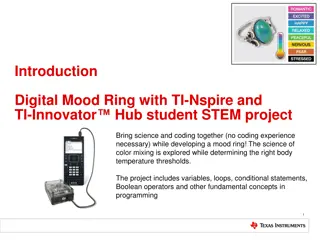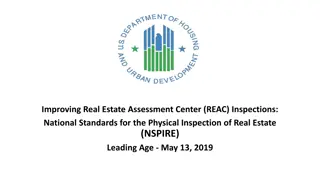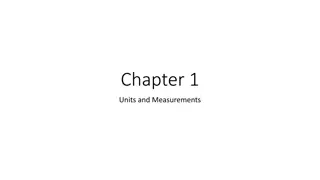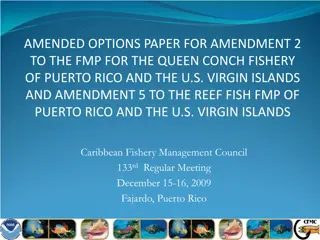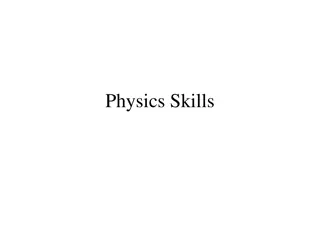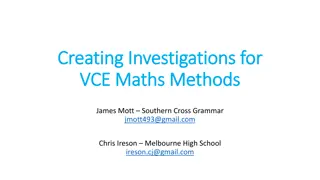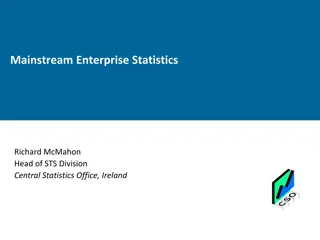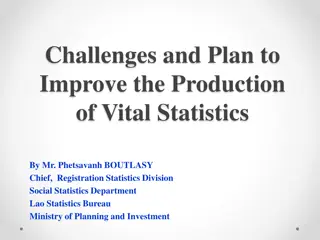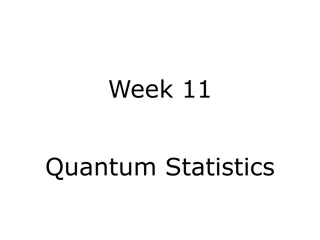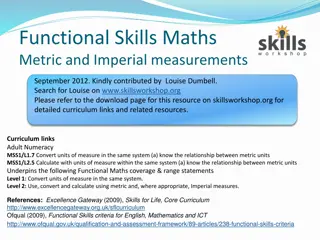Utilizing TI-83/84 and TI-Nspire for Teaching AP Statistics Units 3.5
Explore the integration of TI-83/84 and TI-Nspire in supporting teaching and learning in Units 3.5 of the AP Statistics course, covering collecting data, probability, random variables, probability distributions, and sampling distributions. Dive into a real-world example involving the fit of lids on drink cups to connect concepts from these units and solve probability scenarios. Discover simulation and algebraic methods to determine the probability of large lids fitting on large cups, emphasizing normal distributions and random variables.
Download Presentation

Please find below an Image/Link to download the presentation.
The content on the website is provided AS IS for your information and personal use only. It may not be sold, licensed, or shared on other websites without obtaining consent from the author. Download presentation by click this link. If you encounter any issues during the download, it is possible that the publisher has removed the file from their server.
E N D
Presentation Transcript
Plan for Tonights Office Hours Show how the TI-83/84 and TI-Nspire can be used to support teaching and learning in Units 3 5 of the AP Statistics Course and Exam Description (CED): Unit 3: Collecting Data Unit 4: Probability, Random Variables, and Probability Distributions Unit 5: Sampling Distributions Share a real-world example that connects several concepts in these three units. Answer your questions! 1
If the Lid Wont Fit At fast-food restaurants, drink cup lids are made with a little flexibility so they can be stretched across the mouth of the cup and then snugly secured. When lids are too small or too large, customers can get frustrated, especially if they end up spilling their drinks. One restaurant s supplier claims that the diameter of the large lids follows an approximately normal distribution with mean 3.99 inches and standard deviation 0.01 inches, and that the diameter of the large drink cups follows an approximately normal distribution with mean 3.96 inches and standard deviation 0.015 inch. Assume for now that the supplier s claim is true. For a lid to fit on a cup, the lid diameter must be larger than the cup diameter, but not by more than 0.06 inch. Find the probability that a randomly selected large lid will fit on a randomly selected large cup. 2
If the Lid Wont Fit One restaurant s supplier claims that the diameter of the large lids follows an approximately normal distribution with mean 3.99 inches and standard deviation 0.01 inches, and that the diameter of the large drink cups follows an approximately normal distribution with mean 3.96 inches and standard deviation 0.015 inch. Assume for now that the supplier s claim is true. For a lid to fit on a cup, the lid diameter must be larger than the cup diameter, but not by more than 0.06 inch. Find the probability that a randomly selected large lid will fit on a randomly selected large cup. Method 1: Simulation! 451 500= 0.902 3
If the Lid Wont Fit One restaurant s supplier claims that the diameter of the large lids follows an approximately normal distribution with mean 3.99 inches and standard deviation 0.01 inches, and that the diameter of the large drink cups follows an approximately normal distribution with mean 3.96 inches and standard deviation 0.015 inch. Assume for now that the supplier s claim is true. For a lid to fit on a cup, the lid diameter must be larger than the cup diameter, but not by more than 0.06 inch. Find the probability that a randomly selected large lid will fit on a randomly selected large cup. Method 2: Algebra of Random Variables Let L = diameter of a randomly selected lid and C = diameter of a randomly selected cup. We want to find ?(0 < ? ? 0.06). What do we know about the distribution of L C? Shape: Approximately normal (difference of 2 independent, approximately normal RVs) Center:?? ?= ?? ??= 3.99 3.96 = 0.03 inches Variability:?? ? = ?? 2 2= 0.012+ 0.0152= 0.000325 ?? ?= 2+ ?? 0.000325 = 0.018 inches 4
If the Lid Wont Fit Method 2: Algebra of Random Variables Let L = diameter of a randomly selected lid and C = diameter of a randomly selected cup. We want to find ?(0 < ? ? 0.06). What do we know about the distribution of L C? Shape: Approximately normal (difference of 2 independent, approximately normal RVs) Center:?? ?= ?? ??= 3.99 3.96 = 0.03 inches Variability:?? ? = ?? 2 2= 0.012+ 0.0152= 0.000325 ?? ?= 2+ ?? 0.000325 = 0.018 inches 5
If the Lid Wont Fit Method 2: Algebra of Random Variables Let L = diameter of a randomly selected lid and C = diameter of a randomly selected cup. We want to find ?(0 < ? ? 0.06). What do we know about the distribution of L C? Shape: Approximately normal (difference of 2 independent, approximately normal RVs) Center:?? ?= ?? ??= 3.99 3.96 = 0.03 inches Variability:?? ? = ?? 2 2= 0.012+ 0.0152= 0.000325 ?? ?= 2+ ?? 0.000325 = 0.018 inches ? 0 < ? ? 0.06 0 0.03 0.018 = ? 1.67 < ? 1.67 = 0.9525 0.0475 = 0.9050 < ? 0.06 0.03 = ? 0.018 0 0.06 6
If the Lid Wont Fit The restaurant s manager is suspicious that the supplier s claim is false because many customers have complained that the lids won t fit on their large drink cups. Both the lids and the cups come in boxes of 500 from the supplier. Quality control plan #1: The manager will select a random sample of 40 large cups and a separate random sample of 40 large lids, pair them up in the order of selection, and count how many lids fit their cups. Describe how the manager can use a random number generator to take a random sample of 40 cups (lids) from a box with 500 cups (lids). 7
If the Lid Wont Fit Quality control plan #1: The manager will select a random sample of 40 large cups and a separate random sample of 40 large lids, pair them up in the order of selection, and count how many lids fit their cups. Assuming the supplier s claim is true, how many lids should the manager expect to fit? Let F = the number of lids that fit on their cups. F is a binomial random variable with n = 40 and p = 0.9044. ??= ?? = 40 0.9044 = 36.176 ??= = ??(1 ?) 40 0.9044 0.0956 = 1.86 8
If the Lid Wont Fit Quality control plan #1: The manager will select a random sample of 40 large cups and a separate random sample of 40 large lids, pair them up in the order of selection, and count how many lids fit their cups. The manager carries out this quality control plan and finds that 32 lids fit their cups. (a) Assuming the supplier s claim is true, what is the probability that 32 or fewer lids fit their cups? (b) Is there convincing evidence that the supplier s claim is false? Justify your answer. Yes. If the supplier s claim is true, there is only a 0.033 probability of getting a random sample of 40 lid-cup pairs in which 32 or fewer lids fit their cups. This result gives convincing evidence that the supplier s claim is false. 9
If the Lid Wont Fit Quality control plan #2: The manager will randomly select a large cup and a large lid, and see if the lid fits. This process will continue until the manager obtains a cup/lid pair for which the lid does not fit. Assuming the supplier s claim is true, how many cup/lid pairs should the manager expect to randomly select to obtain a cup/lid pair for which the lid does not fit? Let W = the number of cup/lid pairs the manager has to select to obtain one for which the lid does not fit. W is a geometric random variable with p = 1 0.9044 = 0.0956. ??=1 1 0.0956= 10.46 ?= 1 ? ? 1 0.0956 0.0956 ??= = = 9.95 10
If the Lid Wont Fit Quality control plan #2: The manager will randomly select a large cup and a large lid, and see if the lid fits. This process will continue until the manager obtains a cup/lid pair for which the lid does not fit. The manager carries out this quality control plan and finds that the 29th cup/lid pair is the first one for which the lid does not fit. (a) Assuming the supplier s claim is true, what is the probability that it takes 29 or more cup/lid pairs to find the first one for which the lid does not fit? (b) Is there convincing evidence that the supplier s claim is false? Justify your answer. No. If the supplier s claim is true, there is a 0.06 probability that it will take 29 or more cup/lid pairs to find one that doesn t fit. This result does not give convincing evidence that the supplier s claim is false. 11
If the Lid Wont Fit The restaurant s manager is suspicious that the supplier s claim is false because many customers have complained that the lids won t fit on their large drink cups. Both the lids and the cups come in boxes of 500 from the supplier. Quality control plan #1: The manager will select a random sample of 40 large cups and a separate random sample of 40 large lids, pair them up in the order of selection, and count how many lids fit their cups. Quality control plan #2: The manager will randomly select a large cup and a large lid, and see if the lid fits. This process will continue until the manager obtains a cup/lid pair for which the lid does not fit. Which quality control plan is better? Justify your answer. Quality control plan #1 is better because it will identify when too few lids are fitting their cups based on the supplier s claim. Quality control plan #2 will only provide convincing evidence that the supplier s claim is false if it takes too many cup/lid pairs to obtain one for which the lid does not fit in other words, it the lids are fitting the cups more often than the supplier claimed. 12
Handouts of the slides will be posted <https://education.ti.com/en/bulletinboard/statisticsofficehours>. Questions? Enter them in the chat and we ll get to as many as we can! 13


